The pagefile.sys is an important system file used by Windows to manage virtual memory. When your physical RAM is full, Windows uses the pagefile as temporary storage to prevent system crashes. However, the size of the pagefile can grow significantly over time, consuming valuable disk space. In this guide, we’ll walk you through the steps to reduce or delete pagefile.sys, along with important considerations to ensure your system continues to run smoothly.
What is pagefile.sys
pagefile.sys is a hidden system file that acts as virtual memory. When your physical RAM is insufficient to handle running processes, Windows temporarily uses the pagefile to store data that would otherwise be kept in RAM. This allows your computer to continue running even when memory is scarce.
However, over time, itpagefile.sys can take up significant disk space, especially if you’re using a machine with a lot of memory.
Note: Before modifying or deleting the pagefile, ensure that your system has enough physical RAM. Deleting the pagefile or reducing its size may cause performance issues on machines with low RAM, leading to crashes or slowdowns. If your system relies heavily on virtual memory, it is not recommended to disable the pagefile entirely.
Why is pagefile.sys Takes so Much of Space
This is an ordinary file existing in Windows as the pagefile. The pagefile is a file that exists solely for the purpose of virtual memory management by the operating system and lets the entire file be treated as though it were additional physical memory. The accessed data is moved from the RAM to the hard disk and used only when required. A few things could make this file grow too large.
- The capacity of virtual memory when physical RAM is exhausted.
- The dump from the system crash that keeps information when the system goes down.
- Dynamic resizing done by Windows based on memory demands.
- Hibernate which saves contents of RAM into disk.
- Applications with a lot of memory usage and large amounts of background processes.
This file is usually about 1.5 times larger than the installed RAM, but can be significantly larger depending on the usage and settings of the system.
Is it Safe to Delete pagefile.sys?
Now, one major thing to consider before jumping to delete, move, or resize pagefile.sys is that pagefile stores state information about your PC and programs currently running on it. Thus, deleting it could have possibly bad outcome and ruin the stability of your machine. Pagefile may be occupying a huge amount of space on your drive, but it’s quite the vital necessity for the effective functioning of your computer. This is exactly what makes pagefile.sys hidden by default on Windows 10.
Impact of a Large pagefile.sys on System Performance
The pagefile.sys is a system file used by Windows operating systems as a part of its virtual memory management. It acts as an overflow area for when the physical RAM is fully utilized. The system writes extra data to this file on the hard drive, effectively increasing the amount of RAM available but at the cost of slower access times compared to physical RAM. Here’s how a large pagefile.sys can impact system performance:
Positive Impact:
- Prevents System Crashes: By having a large pagefile, the operating system can accommodate more virtual memory usage, which helps in preventing system crashes due to out-of-memory errors especially in environments running many or resource-intensive applications.
- Enhanced Multitasking: A larger pagefile allows for more programs to run concurrently without exhausting physical RAM, enhancing multitasking capabilities.
Negative Impact:
- Reduced Performance: Access times for data in the pagefile are significantly higher than for data kept in RAM. This can lead to slower system performance, particularly if the system frequently needs to swap information between RAM and the pagefile.
- Disk Space Usage: A large pagefile can consume a considerable amount of disk space, which might be a concern especially on systems with limited storage capacity.
- Fragmentation: Especially when set to a dynamically resizable option, the pagefile can become fragmented over time. Fragmentation of the pagefile may result in degraded performance as the system has to spend more time reading and writing to different areas of the disk.
How to Reduce or Delete pagefile.sys
Although it is not advisable, you can delete the pagefile.sys if you suspect it has been corrupted or is causing any other issues with the system. Follow the steps whereby the file can be located and deleted.
How to Check the Current Size of pagefile.sys
To begin, it’s important to understand the current size of your pagefile and whether it’s using an unreasonable amount of space on your drive.
Step 1: Open the ‘System Properties’ Window (Run)
- Press
Win + R, typesysdm.cpl, and press Enter.
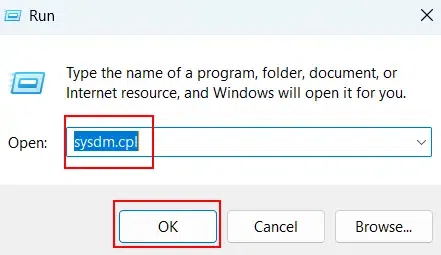
Step 2: Navigate to the Advanced Tab
- In the System Properties window, click on the “Advanced” tab.

Step 3: Access Virtual Memory Settings
- Under the “Performance” section, click on “Settings,” then go to the “Advanced” tab. In the Virtual Memory section, click on “Change”.
Here, you’ll see the current size of your pagefile.sys. You can either leave it as is or adjust the settings.
How to Resize the pagefile.sys
Resizing the pagefile can help optimize disk space usage, especially if your system’s primary storage is limited. By adjusting the pagefile size, you can allocate only the necessary amount of virtual memory, preventing it from taking up excessive space. This allows your system to continue using virtual memory efficiently while freeing up space for other tasks, improving overall system performance.
Step 1: Open Virtual Memory Settings
- Press Win + R, type
sysdm.cpl> hit Enter > in the System Properties window, click Settings under «Performance» > go to the Advanced tab > under «Virtual memory» > click Change.
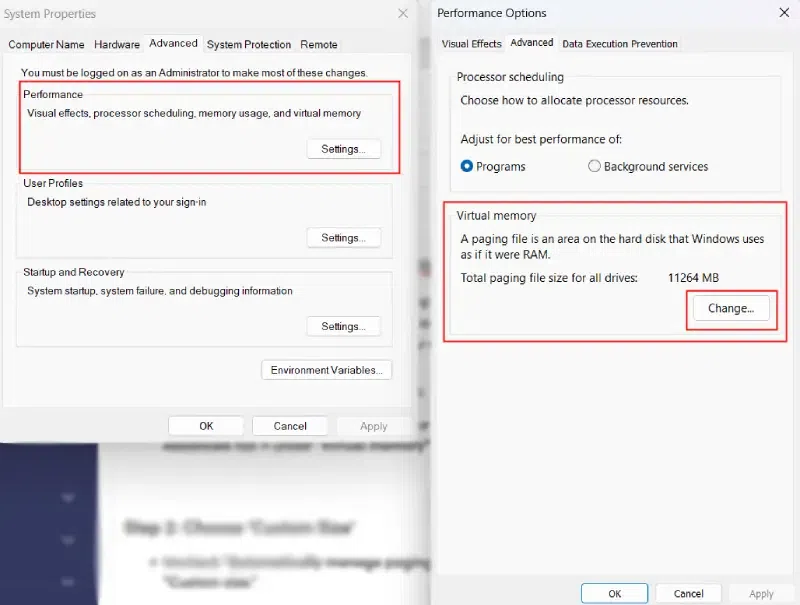
Step 2: Choose ‘Custom Size’
- Uncheck “Automatically manage paging file size for all drives.” Then, select the drive where your pagefile is stored and choose “Custom size.”
Step 3: Adjust the Initial and Maximum Size
- Set both the initial and maximum size to a smaller value based on your needs. A good rule of thumb is to set the initial size equal to your system’s RAM size, and the maximum size to 1.5-2 times your system’s RAM.
How to Move pagefile.sys to Another Drive
Moving pagefile.sys to a secondary drive (if available) can free up valuable space on your system disk while still allowing Windows to use virtual memory efficiently.
Step 1: Open Virtual Memory Settings
- Press Win + R, type sysdm.cpl > hit Enter > in the System Properties window, click Settings under «Performance» > go to the Advanced tab > under «Virtual memory«.
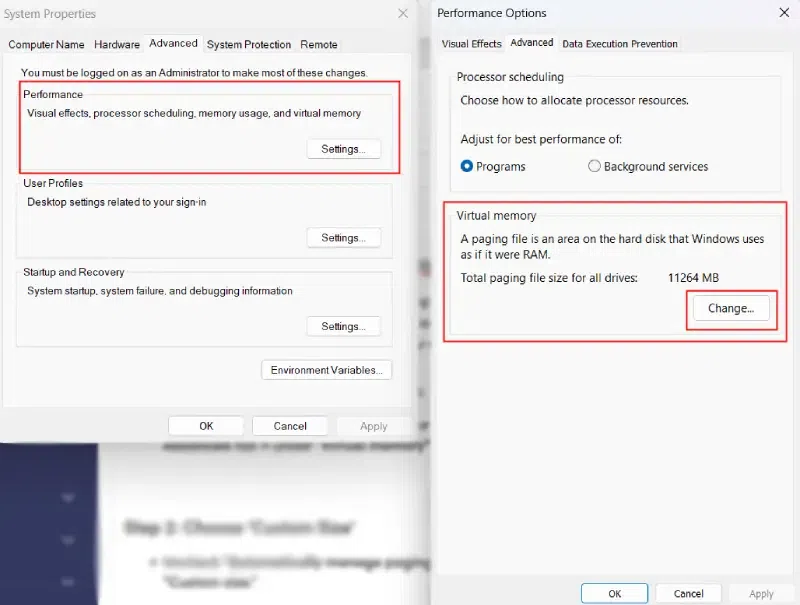
Step 2: Select the New Drive
- In the Virtual Memory settings, select the drive where you want to move the pagefile. This could be an HDD or another SSD with more available space.
Step 3: Set the Pagefile Size
- Choose “Custom size” and set the initial and maximum sizes, as explained in Step 2.
Note: Make sure the drive you choose has sufficient free space and is fast enough to handle the pagefile. SSDs are ideal for pagefile relocation due to their faster read/write speeds, but make sure that the additional writes won’t reduce the lifespan of your SSD.
How to Disable pagefile.sys (Not Recommended)
While it’s technically possible to completely disable the pagefile, it’s generally not recommended unless your system has sufficient RAM to handle memory-intensive applications.
Step 1: Open Virtual Memory Settings
- Press Win + R, type sysdm.cpl > hit Enter > in the System Properties window, click Settings under «Performance» > go to the Advanced tab > under «Virtual memory«.

Step 2: Disable the Pagefile
- In the Virtual Memory window, select “No paging file” and click “Set.”
Important Note: Disabling the pagefile can result in system instability if your system runs low on memory. This should only be done if your system has 16GB of RAM or more and you don’t run memory-intensive applications. Users with limited RAM should never disable the pagefile completely.
How to Delete pagefile.sys (Not Recommended)
If you decide to delete pagefile.sys, follow these steps. However, be aware of the performance implications and system instability this may cause.
Step 1: Disable the Pagefile
- Press Win + R, type
sysdm.cpl> hit Enter > in the System Properties window, click Settings under «Performance» > go to the Advanced tab > under «Virtual memory» > click Change > uncheck Automatically manage paging file size for all drives > select No paging file > click Set > then click OK to disable the pagefile.
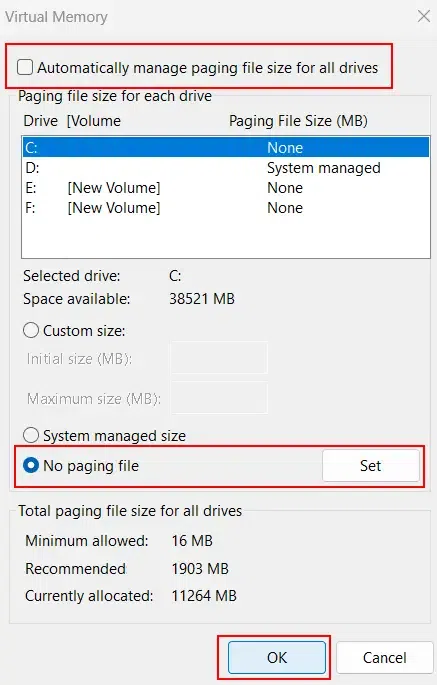
Step 2: Navigate to the Pagefile Location
- Open File Explorer and navigate to
C:\pagefile.sys.
Step 3: Delete the File
- Delete the file manually. You might need to have administrative privileges to do this.
Note: Deleting
pagefile.syscan lead to crashes, especially if your system is under heavy load. Always ensure you have sufficient physical RAM available before attempting to delete the pagefile. It’s usually safer to resize or move the file instead.
Conclusion
Reducing or deleting pagefile.sys can free up valuable space on your system drive, but it comes with risks. It’s crucial to understand how pagefile.sys works and the consequences of modifying or deleting it. Resizing the pagefile or moving it to another drive can be a good compromise to optimize disk space without compromising system stability.
Возвращаясь к вопросу безопасности данных, находящихся в оперативной памяти, столкнулся с необходимостью организации автоматической очистки файла подкачки в Windows. При выключении компьютера, данные в его памяти (RAM) автоматически очищаются, однако по-умолчанию данные из файла подкачки pagefile.sys не удаляются. При работе системы часть конфиденциальных данных или пароли сторонних приложений из памяти могут попасть в файл подкачки pagefile.sys на жестком диске (например, при нехватке физической памяти или при вытеснении данных неактивных приложений). И хотя в процессе работы системы файл подкачки доступен монопольно только для самой Windows, в том случае если компьютер выключить, то потенциально злоумышленник при наличии доступа к диску может скопировать файл подкачки и извлечь из него конфиденциальные данные.
Таким образом, было бы логично очищать при выключении (или перезагрузке) Windows. По умолчанию эта функций отключена.
Включить функцию автоматической очистки файла подкачки при перезагрузке можно через групповую политику либо через реестр.
В первом случае, нужно открыть консоль редактора групповых политик (локальный gpedit.msc или доменный gpmc.msc) и перейти в раздел Computer Configuration->Windows Settings -> Security Settings -> Local Policies -> Security Options. В левой панели найдите политику Shutdown: Clear virtual memory pagefile и включите ее (Enabled).
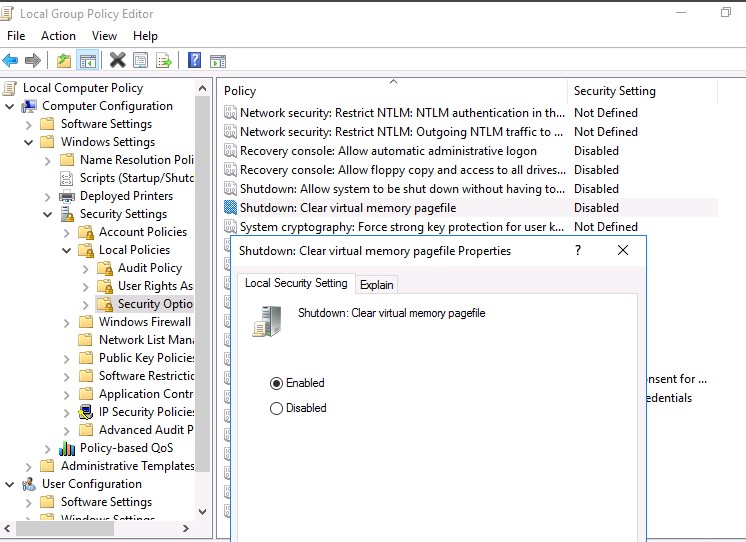
Также можно включить очистку виртуальной памяти через реестр. Для этого откройте редактор regedit.exe и перейдите в ветку HKEY_LOCAL_MACHINE\SYSTEM\CurrentControlSet\Control\Session Manager\Memory Management. Создайте новый DWORD параметр с именем ClearPageFileAtShutdown и значением 1 (или если он уже существует, просто измените его значение).
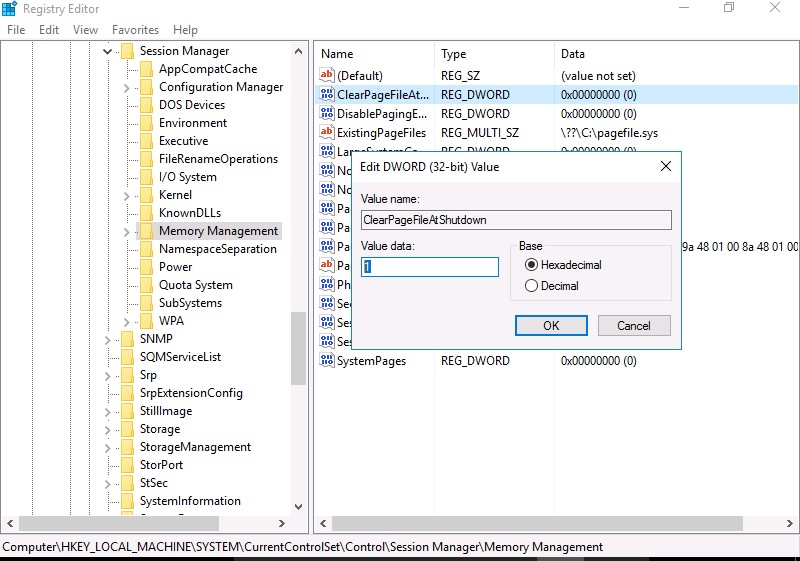
Либо можно изменить значение ключа реестра командой Powershell:
Set-ItemProperty -Path 'HKLM:\SYSTEM\CurrentControlSet\Control\Session Manager\Memory Management' -Name ClearPageFileAtShutdown -Value 1

Чтобы изменения вступили в силу, нужно перезагрузить Windows.
При следующем выключении ОС, система очищает файл pagefile.sys, перезаписывая его нулями. В зависимости от размера файла подкачки это может существенно увеличить время выключения (перезагрузки) системы на 10-30 минут. Кроме того, при включении данной политики также выполняется обнуление и файла режима гибернации hiberfil.sys (если отключен спящий режим). Теперь восстановить данные из файла подкачки практически невозможно.
Прежде всего о том, что такое pagefile.sys в Windows 10, Windows 7, 8 и XP: это файл подкачки Windows. Зачем он нужен? Дело в том, что какое бы количество оперативной памяти не было установлено на вашем компьютере, не всем программам для работы будет ее достаточно. Современные игры, видео и графические редакторы и многое другое программное обеспечение с легкостью заполнит Ваши 8 Гб RAM и попросит еще. В этом случае и используется файл подкачки. Файл подкачки по умолчанию находится на системном диске, обычно здесь: C:\pagefile.sys. В этой статье поговорим о том, хорошая ли это идея — отключить файл подкачки и тем самым удалить pagefile.sys, а также о том, как переместить pagefile.sys и какие преимущества это может дать в некоторых случаях.
Обновление 2016: более подробная инструкция по удалению файла pagefile.sys, а также видео руководство и дополнительная информация доступны в стать Файл подкачки Windows.
Как удалить pagefile.sys
Один из главных вопросов пользователей — можно ли удалить файл pagefile.sys. Да, можно, и сейчас я напишу о том, как это сделать, а далее поясню, почему этого делать не стоит.
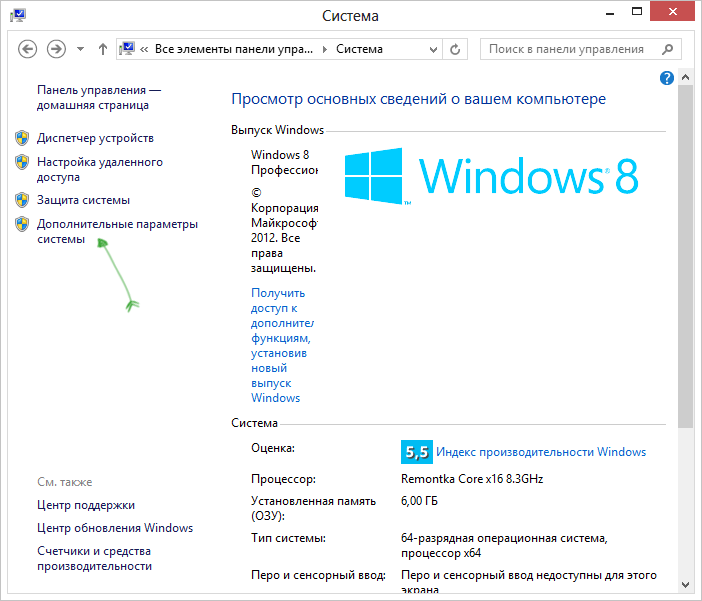
Итак, для того, чтобы изменить параметры файла подкачки в Windows 7 и Windows 8 (и в XP тоже), зайдите в Панель управления и выберите пункт «Система», затем в меню слева — «Дополнительные параметры системы».
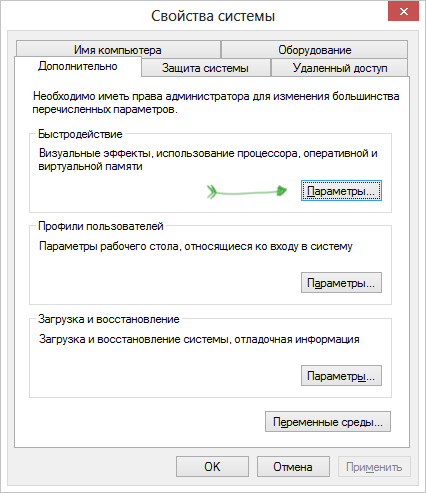
Затем, на вкладке «Дополнительно» кликните кнопку «Параметры» в разделе «Быстродействие».
В параметрах быстродействия откройте вкладку «Дополнительно» и в разделе «Виртуальная память» нажмите «Изменить».
Настройки pagefile.sys
По умолчанию, Windows автоматически управляет размером файла pagefile.sys и, в большинстве случаев это является оптимальным вариантом. Тем не менее, если вы хотите удалить pagefile.sys, вы можете это сделать, сняв галочку «Автоматически выбирать объем файла подкачки» и установив пункт «Без файла подкачки». Также вы можете изменить размер этого файла, указав его самостоятельно.
Почему не следует удалять файл подкачки Windows
Есть несколько причин, по которым люди решают удалить pagefile.sys: он занимает место на диске — это первая из них. Вторая — они думают, что без файла подкачки компьютер будет работать быстрее, так как на нем и так достаточно оперативной памяти RAM.
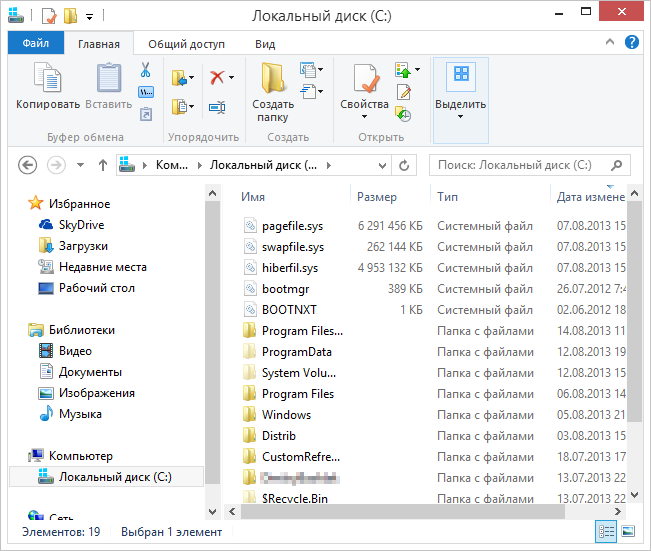
Pagefile.sys в проводнике
Что касается первого варианта, то с учетом объемов сегодняшних жестких дисков, удаление файла подкачки навряд ли может оказаться критически необходимым. Если у Вас стало кончаться место на жестком диске, то скорее всего это говорит о том, что вы там храните что-то ненужное. Гигабайты образов дисков игр, фильмы и прочее — это не то, что обязательно держать на своем жестком диске. К тому же, если вы скачали некий Repack объемом несколько гигабайт, и установили его на компьютер, сам файл ISO можно удалять — работать игра будет и без него. Так или иначе, это статья не о том, как почистить жесткий диск. Просто, если для вас являются критичными несколько гигабайт, занимаемые файлом pagefile.sys, лучше поискать что-то другое, явно ненужное, и оно, скорее всего найдется.
Второй пункт, касающийся производительности — тоже миф. Windows может работать без файла подкачки при условии большого количества установленной оперативной памяти RAM, однако никакого положительного влияния на производительность системы это не имеет. Кроме этого, отключение файла подкачки может привести к некоторым неприятным вещам — некоторые программы, не получив достаточно свободной памяти для работы, будут сбоить и «вылетать». Некоторое программное обеспечение, например виртуальные машины, могут вообще не запуститься, если вы отключите файл подкачки Windows.
Подводя итог, нет разумных причин, чтобы избавляться от pagefile.sys.
Как переместить файл подкачки Windows и в каких случаях это может быть полезным
Несмотря на все вышесказанное об отсутствии необходимости менять стандартные настройки для файла подкачки, в некоторых случаях перемещение файла pagefile.sys на другой жесткий диск может быть полезным. Если у вас на компьютере установлено два отдельных жестких диска, один из которых системный и на нем же установлены необходимые программы, а второй содержит относительно редко используемые данные, перемещение файла подкачки на второй диск может положительно сказаться на производительности в те моменты, когда виртуальная память задействована. Переместить pagefile.sys можно там же, в настройках виртуальной памяти Windows.
Нужно учесть, что это действие разумно только в том случае, когда у Вас два отдельных физических жестких диска. Если же ваш жесткий диск разбит на несколько разделов, перемещение файла подкачки на другой раздел не только не поможет, но в некоторых случаях может и замедлить работу программ.
Таким образом, суммируя все вышенаписанное, файл подкачки — важная составляющая часть Windows и лучше бы Вам его не трогать, если Вы только точно не знаете, зачем вы это делаете.
Пользователи ПК часто спрашивают, для чего нужен огромный файл pagefile.sys, расположенный в корне установочного диска Windows, и можно ли его удалить.
Начнем с того, что файлы подкачки работают как физическое расширение оперативной памяти. Windows 10 перемещает редко или наименее используемые страницы памяти из оперативной памяти ОЗУ в файл подкачки pagefile.sys, когда физическое использование ОЗУ очень велико. Pagefile .sys играет еще одну важную роль. Он записывает информацию о состоянии Windows во время сбоя.
Файл подкачки, или виртуальная память — это системный файл на диске, который система использует, чтобы устранить дефицит оперативной памяти (ОЗУ), если программе или игре ее не хватает.
Могу ли я удалить файл Файл подкачки (pagefile.sys)?
На компьютерах с большим объёмом оперативной памятью Windows 10 может не использовать файл подкачки, поскольку физической памяти может быть достаточно для всех операций. Если у вас на компьютере объем ОЗУ (16 ГБ +), и вы уверены, что программы не будут занимать всю физическую память, вы можете удалить файл pagefile.sys. Короче говоря, чем больше у вас оперативной памяти, тем меньше вам нужно pagefile.sys.
Что произойдет, если я удалю pagefile.sys?
Ну, вы не увидите никакой разницы, если использование физической памяти находится в допустимых пределах. Если использование оперативной памяти достигнет 100%, программы могут зависать или подтормаживать, и вы можете потерять не сохраненный процесс. Поэтому без необходимости лучше не трогать файл pagefile.sys.
Так как pagefile.sys – скрытый системный файл, он не отображается с настройками по умолчанию. Чтобы увидеть его вам придётся включить опцию «Показать скрытые файлы, папки или диски» и снять чекбокс в пункте «Скрывать защищенные системные файлы».
Как и другие системные файлы, вы не можете просто удалить файл pagefile.sys напрямую из Проводника Windows. Чтобы удалить файл pagefile.sys, Вам необходимо отключить функцию файла подкачки. То есть отключение функции файла подкачки автоматически удалит файл pagefile.sys.
ВАЖНО! Отключение файла подкачки или удаление файла pagefile.sys может отрицательно повлиять на общую производительность операционной системы Windows 10. Если вы обнаружите, что Windows 10 не работает должным образом после отключения и удаления файла, снова включите файл подкачки.
Выполните приведенные ниже шаги, чтобы отключить и удалить pagefile.sys в Windows 10.
Шаг 1: Введите Sysdm.cpl в поле поиска «Пуск / панель задач» или в строку меню Выполнить, а затем нажмите клавишу Enter, чтобы открыть диалоговое окно «Свойства системы».
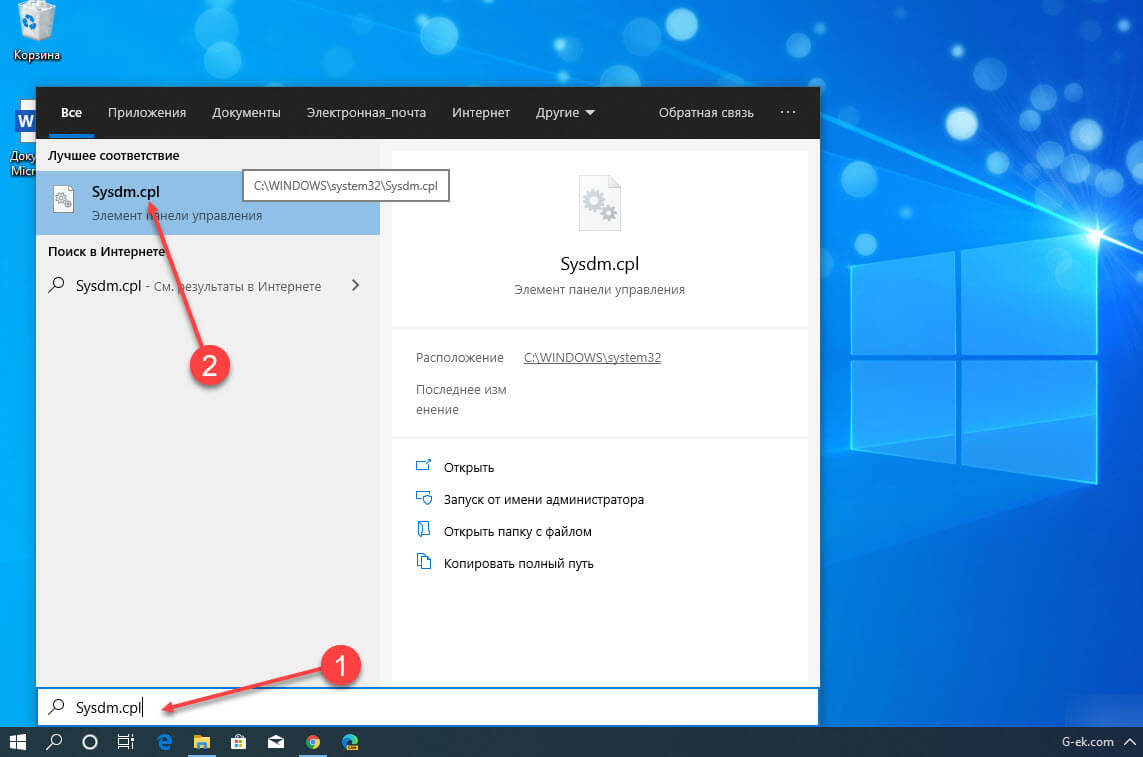
Шаг 2: Переключитесь на вкладку «Дополнительно», нажав на нее. В разделе «Быстродействие» нажмите кнопку «Параметры». При нажатии на кнопку откроется диалоговое окно «Параметры быстродействия».

Шаг 3: Перейдите на вкладку «Дополнительно». В разделе Виртуальная память вы можете увидеть размер файла подкачки. Нажмите кнопку «Изменить…», чтобы открыть диалоговое окно «Виртуальная память».
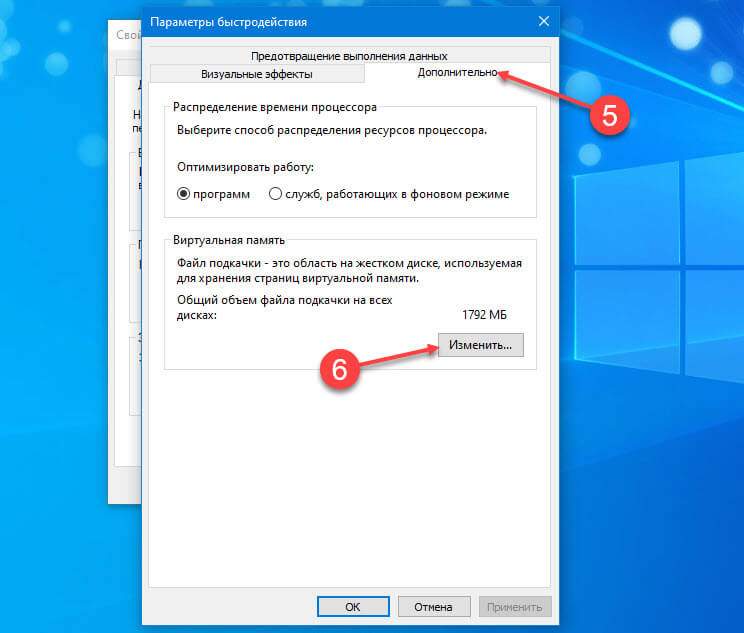
Шаг 4: Чтобы отключить и удалить файл подкачки, снимите флажок «Автоматически выбирать объём файла подкачки». Затем выберите переключатель «Без файла подкачки». Нажмите кнопку «Задать». Нажмите кнопку «Да», когда откроется диалоговое окно с предупреждением. Наконец, нажмите кнопку «Применить».
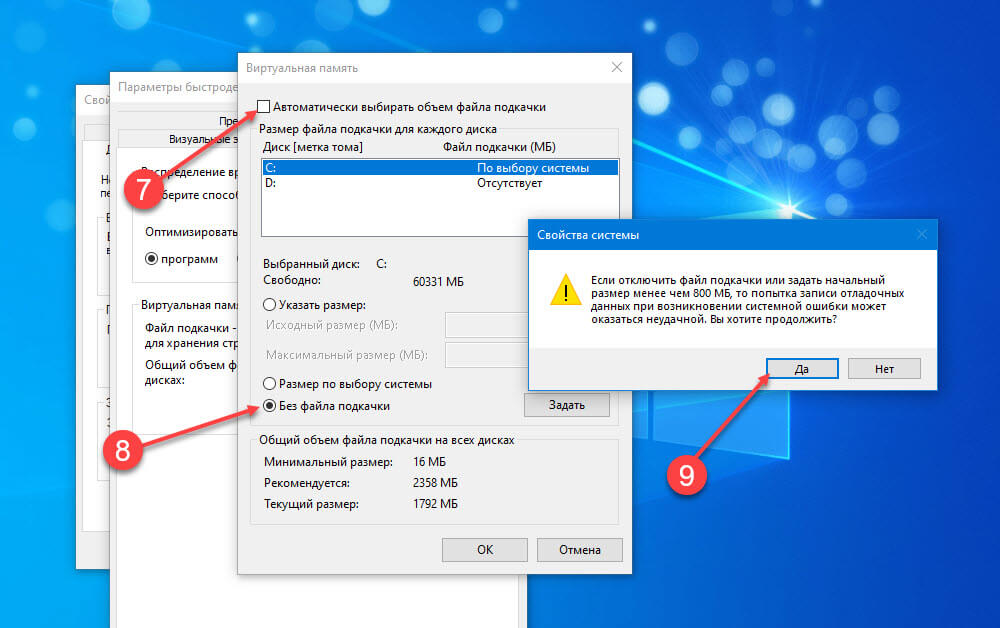
Когда вас попросят перезагрузить компьютер, перезагрузите компьютер один раз, чтобы удалить файл pagefile.sys. Обязательно перезагрузите компьютер.
Чтобы включить файл pagefile.sys
Шаг 1: Следуйте указаниям, упомянутым в шагах 1, 2, 3 и 4 описанного выше способа, чтобы открыть диалоговое окно виртуальной памяти.
Шаг 2: Выберите «Автоматически выбирать объём файла подкачки». Нажмите кнопку «Применить», чтобы включить файл подкачки. При появлении запроса перезагрузите компьютер, чтобы создать файл pagefile.sys.
Все!
As indicated by the Suffix (.sys), pagefile.sys is a System file and a legitimate part of Windows operating system, designed to collect and store data offloaded by various apps and programs running on the computer.
For example, when Apps are minimized, they store their data on the computer’s Random Access Memory (RAM), which allows them to remain active in background and become available for immediate use.
Now, if the RAM requirement on the computer goes up, Windows moves the data of minimized apps from Random Access Memory (RAM) to pagefile.sys, in order to meet the growing RAM requirements on your computer.
This arrangement allows Windows to allocate as much RAM as possible for actively running apps and processes on the computer, while still being able to spring back the minimized apps to life by reading their data from Pagefile.sys.
Advertisement
Is It Safe to Delete Pagefile.sys?
It must be clear by now that Pagefile.sys practically extends the storage capacity of RAM, which should dissuade most users from deleting this file on computers with Low RAM capacity.
In theory, deleting Pagefile.sys on a computer with sufficient RAM capacity (12 to 16 GB) should not lead to any performance issues, as it can be expected to handle most tasks, without the need to store anything in its virtual memory (pagefile.sys).
However, deleting Pagefile.sys on a computer with low RAM capacity can lead to the real possibility of your device being unable to complete certain tasks and coming up with “Out of Memory” or “Not Enough Memory” error messages.
1. Location of Pagefile.sys on Windows Computer
Unless changed or modified by the user, the default location of Pagefile.sys in Windows 11/10 is at root folder of the local drive (C:) on your computer.
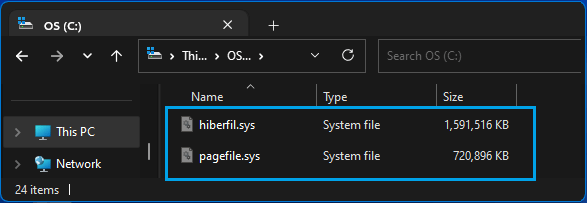
Being a system file, Windows operating system keeps pagefile.sys hidden, in order to prevent the possibility of system files being accidentally deleted on your device.
Hence, you need to enable the option to Show Hidden System Files on your computer, in order to take a look at the amount of storage space occupied by Pagefile.sys on your device.
2. How to Check the Size of Pagefile.sys?
As mentioned above, you can check the amount of storage space occupied by Pagefile.sys on your computer by enabling the option to Show Hidden Files in File Explorer.
1. Open the File Explorer on your computer.
2. On File Explorer window, click on This PC in the left-pane and double-click on your Local Drive (C:) in the right pane.
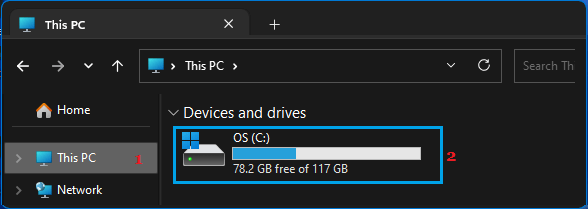
3. Next, click on 3-dots icon in the top-menu and select Options.
Advertisement
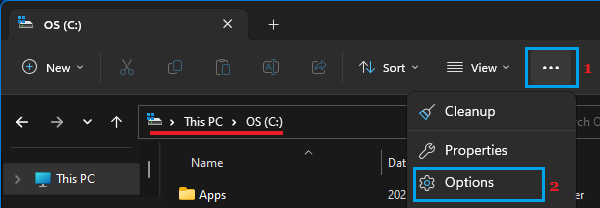
Note: If you are using Windows 10, click on the File Tab and select Change Folders and Search options in the menu that appears.
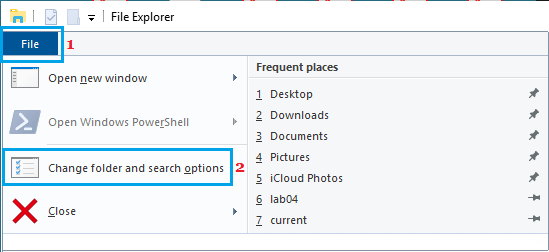
4. On Folder Options screen, switch to View tab > select Show hidden files, folders, drives option and uncheck Hide protected operating system files (Recommended) option.
5. Click on Apply and OK to save the changes
6. After this, scroll down in your Local Drive and you will be able to see Pagefile.sys.
If you find Pagefile.sys file being large in size, you may think in terms of deleting the file to free up storage space on your computer.
3. How to Delete Pagefile.sys?
While it is easy to access Pagfile.sys on a Windows computer, deleting Pagefile.sys is not easy as this file is constantly being used up by the operating system.
When you try to delete pagefile, you will run into “The action can’t be completed because the file is open in another program” error message, which will make it impossible for you to delete this file.
Hence, the first step is to prevent the computer from using virtual memory (paging file), after which you should be able to delete Pagefile by going to its location on your computer.
1. Right-click on the Start button and click on Run.
2. In the Run Command window, type SystemPropertiesAdvanced and click on OK.
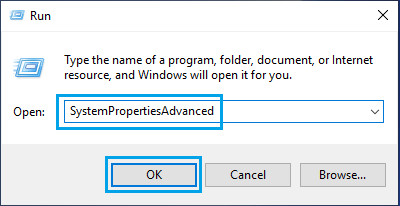
3. On System Properties screen, switch to Advanced tab and click on the Settings button, located under “Performance” section.
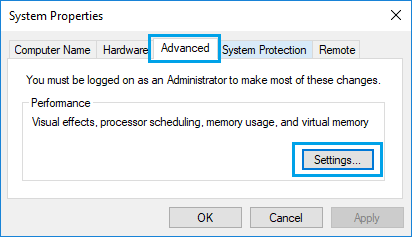
4. On Performance Options screen, switch to Advanced tab and click on the Change button, located under Virtual Memory section.
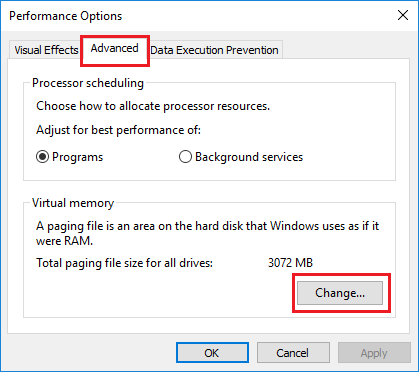
5. On Virtual Memory screen, uncheck Automatically manage option, select your Hard Drive, select No Paging File option and click on the Set button.
6. On the pop-up, click on OK to restart the computer.
After the computer restarts, you should be able to delete Pagefile by going to to its location on your computer – This PC > Local Drive (C:).
4. How to Resize Pagefile.sys?
Instead of deleting Pagefile.sys, you can consider the option reducing the size of Pagefile.sys on your computer.
1. Right-click on the Start button and click on Run.
2. In the Run Command window, type SystemPropertiesAdvanced and click on OK.

3. On System Properties screen, switch to Advanced tab and click on the Settings button, located under “Performance” section.

4. On Performance Options screen, switch to Advanced tab and click on the Change button, located under Virtual Memory section.

5. On Virtual Memory screen, uncheck Automatically manage option, select your Hard Drive, select Custom size option, type your desired Initial size and Maximum Size values and click on the Set button.
Note: You can set initial size to 1.5 times and maximum size to 3 times the available RAM on your computer.
6. Click OK to close the Virtual Memory screen and Restart the computer to implement this change.
5. How to Restore Pagefile.sys?
If you are experiencing problem after deleting Pagefile.sys file, you can follow the steps below to restore Pagefile.sys on your computer.
Note: If your computer is struggling, you can enable Safe Mode on the computer, which makes it easy to delete Pagefile.sys.
1. Right-click on the Start button and click on Run.
2. In the Run Command window, type SystemPropertiesAdvanced and click on OK.

3. On System Properties screen, switch to Advanced tab and click on the Settings button, located under “Performance” section.

4. On Virtual Memory screen, make sure Automatically manage paging file size for all drives checkbox is selected.
5. Click on OK to close Virtual Memory screen and Restart the computer.
Once the computer restarts, you will see Pagefile.sys is along with Swapfile.sys back on your computer.
